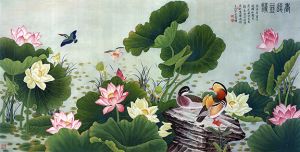About Taranatha
Taranatha,[53] whose real name was Kunga Nyingpo (Skr. Ananadagarbha), was born in 1575 at Kharag Khyungtsun. He was one of the major scholars of his age,
for which reason he was known as ‘revered’ Taranatha.[54] This title was often applied to major authorities in the doctrinal and religious field. Taranatha was also one of the main representatives of the Buddhist school known as Jonangpa,[55] which was famous for its peculiar philosophical outlook known as
shentong, ‘voidness of heterogeneous factors’, which postulates the existence of an absolute and stable reality: any factor that is extraneous to it, or heterogeneous, is void. This doctrine was not in accordance with the Madhyamika doctrine of rangtong, the officially accepted doctrine of the Gelugpa school[56] in Tibet, which postulates that all reality is in itself void. For this reason the Jonangpa doctrine was strongly opposed, even though many famous and learned masters adhered to it.[57] Another reason for criticism was that the Jonangpa school founded its doctrine on both Sutra and Tantra. In
fact its main doctrinal and theoretical foundations draw from sutras, such as the Tathagatagarbhasutra, and tantras, such as the Kalachakra Tantra. The Jonangpa School originated in Tsang.[58] It is named after the homonymous locality and monastery where it started.[59] It was founded by Dolbupa Sherab Gyaltsen (1292-1361), who was known as The Omniscient.[60] He was a disciple of Yumo Mikyö Dorje, who in his turn was a disciple of Chandranatha,[61] a pandit from Kashmir. The Jonangpa school was strongly opposed by the Fifth Dalai Lama: many Jonangpa texts were destroyed and its main centres, such as
Jomonang, were transformed into Gelugpa centres. The lineage of reincarnation to which Taranatha belonged moved to Mongolia, where the Jetsun Tampa Khutukhtu[62] Losang Tenpai Gyaltsen (1635-1723) was born. He was considered to be the subsequent reincarnation of Taranatha, the seventeenth in the
lineage. This is a reference point regarding the date of Taranatha’s death, which is still uncertain. Taranatha received teachings from the oral tradition, which was passed down directly from the Indian Siddhas. The authenticity of such teachings is fully demonstrated in all of his writings. His main guru was Buddhaguptanatha, a direct disciple of the Mahasiddha Shantigupta.[63]
Taranatha’s major works are: a collection of biographies of the main Indian Siddhas, The Seven Instruction Lineages (An Account of the Lineage Histories of the Seven Instructions, which can be Likened to a Marvelous Vein of Jewels),[64] written in 1660, and a history of the cult of Tara, The Account which
Clarifies the Origin of the Tara Tantra, which is Similar to a Golden Necklace.[65] His most important work, written in 1608, is The Book which Fulfills All Wishes, which Shows Clearly how the Precious and Sacred Teaching, Source of Glory, Spread in India, a history of Indian Buddhism.[66] Taranatha -
together with Putön - was one of the few Tibetan historians who dealt with Indian Buddhism as the main subject and not just as reference material for the history of Tibetan Buddhism. Taranatha, who is one of the few sources of information regarding the final period of Buddhism in India, also wrote a history
of the Kalachakra Tantra as well as two auto-biographies, a longer one and a shorter, ‘secret’ one. In 1610, at the age of thirty-six, as stated in the colophon, he completed the biography of Padmasambhava which is the subject of the present study.
The text[67] was written with the aim of shedding light upon the countless stories regarding the life of Padmasambhava, which, according to Taranatha, were not always reliable.[68] It is subtitled ‘in the Indian style’,[69] since Taranatha mostly relied upon Indian sources, such as the Indian oral tradition of
the Mahasiddhas, as transmitted to him by his guru Buddhaguptanatha. He also consulted the main texts of the kama tradition, i.e. The Garland of Views of the Secret Methods and the series of texts on Vajra Kilaya and Hayagriva,[70] comparing them with each other and with the Tibetan historical documents that
were available to him, such as the Bashe.[71] It resulted that the kama texts mostly agree with each other and with the Bashe regarding the account of Padmasambhava’s birth and sojourn in Tibet. The edition of the text that has been used here is a reproduction of
a 19th century reprint of some printing-blocks from Dege, in Eastern Tibet. This reprint came from the Riwoche Jedrung library of Padma Köd, and was published in 1974 by the Tibetan Nyingmapa Monastery, A.P. (India), with the title of Five Historical Works of Taranatha
